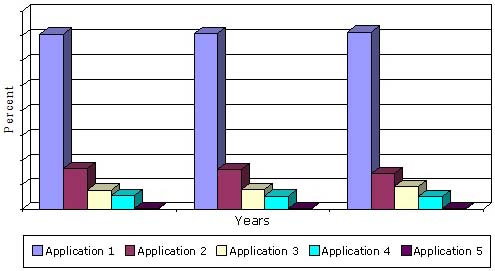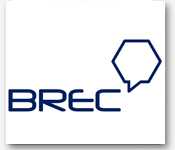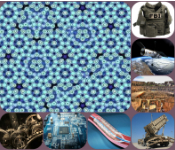Smart Materials are designed/engineered materials that have one or more properties that can be significantly changed in a controlled fashion by external stimuli, such as stress, temperature, moisture, pH, electric or magnetic fields. It deals with Science and technology in the fields of material engineering like nanomaterial and biological used materials. Development of civil, aerospace and mechanical engineering structures and advances in defence, by studying physical and chemical properties help synthesis of smart materials for electronics.
Track 1. Smart materials
Smart materials are designed materials that have one or more properties that can be significantly changed in a controlled fashion by external stimuli, such as stress, temperature, moisture, pH, electric or magnetic fields.
Track 2. Composite materials
A composite material is a material made from two or more constituent materials with significantly different physical or chemical properties that, when combined, produce a material with characteristics different from the individual components.
Track 3. Piezeoelectric materials
The piezoelectric effect of natural monocrystalline materials such asquartz, tourmaline and Rochelle salt is relatively small. Polycrystalline ferroelectric ceramics such as barium titanate (BaTiO3) and lead zirconate titanate (PZT) exhibit larger displacements or induce larger electric voltages.
Track 4. Smart materials Textiles
E-textiles, also known as smart garments, smart clothing, electronic textiles, smart textiles, or smart fabrics, are fabrics that enable digital components (including small computers), and electronics to be embedded in them.Smart textiles are fabrics that have been developed with new technologies that provide added.
Track 5. Smart Materials and structures
Smart Materials and Structures is a multi-disciplinary journal dedicated to technical advances in (and applications of) smart materials, systems and structures; including intelligent systems, sensing and actuation, adaptive structures, and active control.
Track 6. Applications of Smart Materials
Smart materials got vast applications in Aerospace, Mass transit, Marine, Automotive, Computers and other electronic devices, Consumer goods applications, Civil engineering, Medical equipment applications, Rotating machinery applications.
Track 7. Polymer composites and smart Materials
Many well-defined structures such as metals, ceramics or polymers cannot satisfy all technological demands. Therefore, there is ongoing search for new materials with new, and especially improved properties. Such a task is met by, among others, composite materials that are defined as materials composed of at least two phases, where due to the occurring synergistic effect the material of different properties than properties of the components is formed.
Track 8. Smart Fabrics
The health and beauty industry is also taking advantage of these innovations, which range from drug-releasing medical textiles, to fabricwith moisturizer, perfume, and anti-aging properties.Many smartclothing, wearable technology, and wearable computing projects involve the use of e-textiles.
Track 9. Sciences and Applied Technologies
Sciences and Applied Technologies are leading to advance the materials study like Piezoelectric, Shape memory and Phase change materials, CMOS-MEMS, Ceramics, Electrostrictive and Magnetostrictive materials, Smart Polymers, Smart textiles and materials which are yet to be discovered and to be simplified for rational application and technology implication.
Track 10. Architecture and Civil Engineering
Intelligent Structures of Architecture and Civil Engineering are been a subject to reveal and unlock the ancient and magnificent architecture by human on the redesigning the earth's geography. The research on archeological technology of Structural engineering, advanced innovations in civil Engineering, current applied principles of geotechnical, structural, environmental, transportation and construction engineering, sea defense systems against raising sea levels, under water-on water constructions, floating and green cities architecture, case study on Structural & Civil Engineering.
Track 11. Nano Materials
Nano Materials are designed materials with advanced benefits in various fields of Science, available in variable modes. These materials weigh light but sound hard in the material science Subject. Nano materials are smart materials with definite designed structures. As on 2014 $88 million of venture capital investment was received by nanotechnological companies. Smart materials-2016 anticipating researchers on topics Nano Structures, Nano Electronics, Nanotechnology in Energy System, Graphene, Carbon Nanotube, Terahertz nanotechnology, Recent trends in Nano technology.
Track 12. Aerospace Engineering
Smart Materials has vast applications in Aerospace Engineering for designing and withstanding the pressure and torque produced by craft and atmosphere. In aerospace engineering structural designing and materials are more important which helps aircraft to fly in the sky accordingly. Smart Materials & Structures dealing with Aerodynamics & Aero-acoustics, fiber Reinforced glass & reinforced carbon, High-Temperature Reusable Surface Insulation Tiles, Glass Reinforced Aluminum, carbon laminate & carbon Sandwich composites, toughened Graphite, propellant in aerosols etc.
Track 13. Automobile Engineering
Automobile Engineering is a study of mechanical, electrical, electronic, software and safety engineering as applied to the design, manufacture and operation of automobiles. Every automobile gets a structure & works with a specific engine with significant materials and Structure, handled by Mechanical engineering. Mechanical engineering applies the principles of engineering, physics, and materials science for the design, analysis, manufacturing, and maintenance of mechanical systems.
Track 14. EEE
World today got addicted to electric & electronic systems, as generations passing the complex electric & electronic systems turned to simple sophisticated units. Every semi-conductor with nano structures as smart materials. Blue LED electrical semiconductor of Isamu Akasaki, Hiroshi Amano and Shuji Nakamura were rewarded for inventing a new energy- efficient and environment-friendly light source with Noble Prize in 2014.
Track 15. Biological & Medical
Biological & Medical applicable Smart Materials dealing with medical and some bio applicable smart materials. Which include Applied smart / Nano technology in drug and pharm, Smart Hormones for Smart devices, Biosensors and Biomimetic Devices, Spider silk, Nitinol, Scaffolds in tissue engineering bone and cartilage, Applicable Materials for Human body etc.
Track 16. Defence
History reveals that most advances in technology across the world developed during war for destruction and later used for Construction. Wernher von Braun Knew as father of rocket science. He was aerospace engineer for Germany during World War-2 and built liquid fuel aircraft with rocket power for the first time, post war he worked for NASA in Building Saturn V. unlike many more technical advances processed in defence till this day, many were classified but only certain researches can be revealed and helpful in construction of world relation.
Track 17. Synthesis
Current day materials research is mostly on synthesis of smart materials and their physical and chemical properties. You can share your research on Hybrid Carbon Glass & self-cleaning glass, LED’s, Fuel cells, Sensors, Smart Coating, Smart rubber etc.
Track 18. Physical & Chemical properties
Physical properties deals with stydy of structural, crystallographic, stimulai of materials. Chemical properties deals study of materials under chemical and environmental conditions.
BCC (www.bccresearch.com) reveals in its new report on smart materials, the global market was valued at $23.6 billion in 2013 and almost $26 billion in 2014. This is anticipated to reach over $42.2 billion in 2019 at a compound annual growth rate (CAGR) of 10.2% between 2014 and 2019. Motors and actuators make up the largest application segment of the market, with sales of nearly $16.8 billion (70.8% of the market) in 2013, increasing to $30.2 billion (nearly 71.6% of the market) by 2019.
Smart materials are a class of materials that respond dynamically to electrical, thermal, chemical, magnetic or other stimuli from the environment. These materials are incorporated in a growing range of products, enabling these products to alter their characteristics or otherwise respond to external stimuli.
The Asia-Pacific region accounted for the largest production of smart materials in 2013, followed by the U.S. and Europe. However, European production is projected to grow somewhat more slowly than the global average (i.e., at a CAGR of 9.9%). The U.S. share of global smart materials production is projected to increase from 28.2% in 2013 to 29% in 2019.
Smart Materials and Their Applications: Technologies and Global Markets analyzes the principal end-user segment for each type of smart material (including commercial, industrial, medical, research and military) and estimates the current and projected worldwide market for each type of smart material and application through 2019.
SAMPLE FIGURE
GLOBAL MARKET SHARE FOR SMART MATERIALS BY TYPE OF APPLICATION, 2013-2019
(%)
BCC report Smart Materials Industry to Record CAGR of 10.2% through 2019; Phase-Change Materials Hold the Highest Potential












